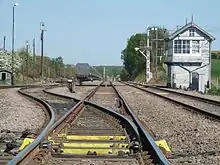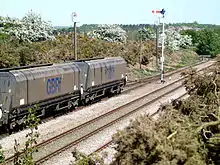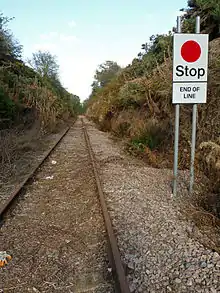High Marnham Test Track
The High Marnham Test Track is a linear railway test track created in 2009 and centred on Lodge Lane, Tuxford, in Nottinghamshire in the United Kingdom.[1]:4,8 It houses Network Rail's Rail Innovation & Development Centre (RIDC),[2]:1 originally known as the Rail Vehicle Development Centre (RVDC).[3] The main route is approximately 14 miles (23 km) long[3] and rated for speeds up to 75 miles per hour (120 km/h).[4] It is primarily formed of a 10 1⁄2-mile (17 km) former section of the Lancashire, Derbyshire and East Coast Railway running between Thoresby Colliery Junction at the western end, and High Marnham Power Station at the eastern end.[2]:2[3] Additionally a 4-mile (6 km) branchline diverges northwards over the Bevercotes Colliery Branch via Boughton Brake Tunnel to Bevercotes.[1]:4[2]:2
| High Marnham Test Track | ||||||||||||||||||||||||||||||||||||||||||||||||||||||||||||||||||||||||||||||||||||||||||||||||||||||||||||||||||||||||||||||||||||||||||||||||||||||||||||||||||||||||||
|---|---|---|---|---|---|---|---|---|---|---|---|---|---|---|---|---|---|---|---|---|---|---|---|---|---|---|---|---|---|---|---|---|---|---|---|---|---|---|---|---|---|---|---|---|---|---|---|---|---|---|---|---|---|---|---|---|---|---|---|---|---|---|---|---|---|---|---|---|---|---|---|---|---|---|---|---|---|---|---|---|---|---|---|---|---|---|---|---|---|---|---|---|---|---|---|---|---|---|---|---|---|---|---|---|---|---|---|---|---|---|---|---|---|---|---|---|---|---|---|---|---|---|---|---|---|---|---|---|---|---|---|---|---|---|---|---|---|---|---|---|---|---|---|---|---|---|---|---|---|---|---|---|---|---|---|---|---|---|---|---|---|---|---|---|---|---|---|---|---|---|
| ||||||||||||||||||||||||||||||||||||||||||||||||||||||||||||||||||||||||||||||||||||||||||||||||||||||||||||||||||||||||||||||||||||||||||||||||||||||||||||||||||||||||||



The main test track passes on a bridge directly over the East Coast Main Line, at the location of the former Dukeries Junction interchange station, but without a rail connection being provided.[5] Instead the test track is accessed from the national British railway network via Shirebrook Junction on the Robin Hood Line and the existing line from there to Thoresby Colliery Junction.[1]:4[5] Access for trains is protected by an Annett's key under the supervision of an Engineering Technical Officer.[2]:2 There is no signalling on the line owing to theft and vandalism, including the previous destruction of the Ollerton Colliery signal box.[3]
Re-opening
On 10 February 2009 975025 Caroline visited the line on inspection duties prior to re-opening.[6] Network Rail announced their intention for the reopening between Thoresby Colliery Junction and High Marnham on 10 July 2009.[7] In August 2009 Network Rail stated that because the route of the line would now be maintained, it might increase the likelihood of being able to restore a passenger service in connection with Robin Hood Line services at a later date.[8]
In November 2011 local people were reminded about the operational nature of the test track following acts of trespass.[4]
During 2012 the Branch Line Society announced their intention to run a railtour covering the main test track and special steep gradients; plus the Bevercotes Branch to a distance of 2 miles 10 chains (3.4 km).[9] Such a tour ran on 5 January 2013[10] and was widely reported in the railway enthusiast press.
This line has been identified by Campaign for a Better Transport as a priority 1 candidate for reopening.[11]
Facilities
The test track includes short sections of non-energised 25 kV AC railway electrification and non-energised third/fourth rail,[1]:11 a W6A loading gauge,[1]:11 and facilities for ERA Technical Specifications for Interoperability (TSI) noise testing.[1]:11
An area of special track exists for RIS-1530-PLT testing of on-track plant, including lengths of track for brake testing at up to 1:25 and sharp 80-metre (4-chain) reverse curves.[1]:5,11 The Lodge Lane area also contains portacabins for visiting staff, and a 300-square-metre (3,200 sq ft) inspection shed for railway vehicles.[1]:8
Projects
In March 2012 braking tests were undertaken for fitments of improved hydraulic brakes to 450 road-rail vehicle excavators.[12] These excavators were all falling under classification "type 9b" where the rubber wheel touch small flanged steel wheels, which in-turn touch the rails and were found to have significantly reduced braking performance in adverse conditions.[12]
In August 2012 the line was used for the testing of RFID and iPad-based "Virtual Lineside Signalling".[13] Funding came from a Department of Transport £100,000-grant to investigate the possibility for low cost system for locations where European Rail Traffic Management System installation is not viable. RFID tags are placed on the track, and contact with a central signalling location is maintained by using encryption over traditional GSM networks and off-the-shelf portable computers used for the cab display.[13]
In October 2013 a new high output "factory train" which will be used on Great Western Main Line electrification is due to be brought from Germany to the test track for trialling and staff familiarisation.[14]
References
- "Rail Innovation and Development Centre" (PDF). 21 June 2012. Archived from the original (brochure) on 21 May 2012. Retrieved 1 September 2012.
- "Rail Innovation & Development Centre – Site Data" (PDF). Network Rail. 6 August 2010. Archived from the original (presentation) on 21 May 2012. Retrieved 31 August 2012.
- O'Connor, Adam (18 September 2009). "Testing times at High Marnham". Rail Staff. Retrieved 31 August 2012.
- "Tuxford track trespassers 'risk serious injury'". BBC News Online. 28 November 2011. Retrieved 28 August 2012.
- Rail Innovation and Development Centre, High Marnham (PDF) (Map). Network Rail. 3 August 2010. Archived from the original (map) on 21 May 2012. Retrieved 1 September 2012.
- "Picture of the Day 11 February 2009". The Railway Centre. 11 February 2009. Retrieved 31 August 2012.
- "Preparing for the Future: Network Rail Opens Vehicle Development Centre". Press Releases (Press release). Network Rail. 10 July 2009. Retrieved 31 August 2012.
- "Hope for Robin Hood branch line". BBC News Online. 9 August 2009. Retrieved 1 September 2012.
- "BLS Lowland Tracker Saturday 22nd September 2012" (PDF). Branch Line Society. 28 July 2012. Retrieved 1 September 2012.
- High Marnham and Tinsley Railtour: via sixbellsjunction
- "Preventing runaways". The Rail Engineer. 15 March 2012. Retrieved 31 August 2012.
- "Off-the-shelf signalling trials". Railway Gazette. 27 August 2012. Retrieved 31 August 2012.
- Clifton 2013, p. 14.
Sources
- Clifton, Paul (2013). Harris, Nigel (ed.). "Network". RAIL. Peterborough: Bauer Consumer Media (727).